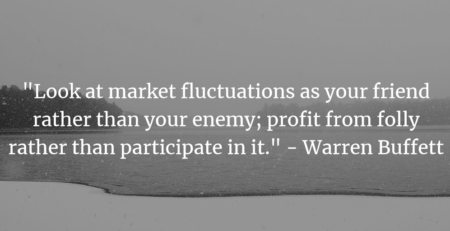Diversification: Conventional Wisdom is Misleading
You might be familiar with the expression “don’t put all your eggs in one basket”. We prefer the expression popularized by Warren Buffett: “Put all your eggs in one basket, and then watch that basket very closely.”
We firmly believe that despite what you may have been told, simply holding many different equities is not the best way to reduce risk in a portfolio. Instead, the best way to reduce risk in a portfolio is to only own assets that you know and understand. For example, owning 5 companies that you know inside out is far less risky than owning 500 companies you know nothing about. As such, we at Globescan do not hold a hugely diversified portfolio (by industry standards), and we believe doing so would only serve to dilute our high return investments with average ones, while leaving us no better off on the risk front.
Our approach is at odds with most traditional business schools, most investment managers, and it is certainly at odds with the biggest money managers in the world. Let us explain why.
The basic conventional wisdom says that to minimize risk, one should own lots of different, preferably uncorrelated, investments. This does make sense intuitively – after all, you are far less likely to experience a substantial loss if you own tiny percentages of many different stocks than if you own a larger percentage of one. However, that works in reverse as well – you are far less likely to experience significant gains through diversification. Said another way: diversification leads to average results.
But it is worth understanding that these average results do have a place in our industry. For most retail investors, who cannot invest the time nor have the expertise or experience in this line of work, diversification makes sense. Think about the statement we made earlier in another way – it is absolutely safer to own 500 companies that you know nothing about than it is to own 1 company that you also know nothing about. But for those with the time, knowledge, and expertise to devote to thoughtful investment, we argue that a better strategy altogether would be to own a few companies that you actually know something about.
Sadly, in our industry, there are thousands of professional investors who use diversification as an excuse to avoid doing the hard work of understanding the companies they own. These financial advisors are often paid lavishly to produce above-average investment returns, but instead, they end up so diversified that they produce the same average results that any retail investor with an index fund could achieve (and actually worse after fees). Consider that most mutual funds that claim to be active funds are much closer to passive funds – they simply hold too many stocks to generate returns that are much different than the index. In 2019, more than 90% of all US mutual funds held more than 35 stocks, and most of those more than 60.
Why does this happen in our industry? Because most investment managers are selling a product rather than selling above actual above-average investment returns. The best way to ensure that this product remains sellable is to make sure that it does not underperform their peers or the market in the short run. The best way not to underperform peers or the market in the short run is to do what peers/ the market are doing.
This line of thinking ultimately results in an equilibrium where professional investors over-diversify to the point that they are mostly producing passive returns but charging active fees. Small wonder active management has had such a poor reputation over the last decade. To some extent, it makes sense, because most active managers aren’t really active.
Real active investing is about doing the hard work of finding high-quality businesses at attractive prices and betting big when you do. This is because high-quality companies are rare. High-quality companies trading at attractive valuations are even rarer. If we forced ourselves to hold more positions despite this fact, we would simply end up with many average investments.
Thoughts on Portfolio Size
This is where the academics begin to contradict themselves – it is well documented that once you pass about 20 stocks, any mathematical diversification benefit from adding one more is marginal at best.
Without getting into the underlying math here, at 20 stocks your average position size is 5%. At 5%, a stock can halve in value and it only hurts your portfolio by 2.5%. So, in terms of single stock risk, even a portfolio that is very concentrated by industry standards is not taking a huge amount of single stock risk. This is where our portfolio usually sits.
Thoughts on Risk Management
Let us address diversification from a risk perspective. Imagine a friend of yours wins the lottery and wants to invest their cash in businesses to generate income so they no longer need to work. Would it be more sensible to carefully analyze, understand and then purchase the three best businesses in town (maybe the grocery store, the bank, and the most popular restaurant), or would it make more sense to blindly buy 50 different businesses without looking into them at all? Clearly, it is the former.
The exact same principle applies to the stock market. It is far less risky to own a small number of companies that you know extremely well and in which you can be confident in the future earnings potential than it is to own 500 companies you know nothing about.
For more information on this topic see our previous writings on the subject here. In short, we maintain that the best risk control is to understand what you own. This means doing the hard work of analyzing companies and selecting the best that you can find. And when you find great companies that you can buy at a great price, do not be afraid to concentrate.
Investors who take this practical approach and focus on underlying earnings power over a 3, 5, and 10-year period can be confident in those earnings, regardless of what the share prices might do in the short term. It is precisely this sort of approach that gives investors such as us the confidence to step in and buy or add to names that are being unfairly marked down in the prevailing market conditions, and furthermore concentrate their portfolio in their best ideas. This is how real active investors can outperform the market over the long run.
Disclosures: This website is for informational purposes only and does not constitute an offer to provide advisory or other services by Globescan in any jurisdiction in which such offer would be unlawful under the securities laws of such jurisdiction. The information contained on this website should not be construed as financial or investment advice on any subject matter and statements contained herein are the opinions of Globescan and are not to be construed as guarantees, warranties or predictions of future events, portfolio allocations, portfolio results, investment returns, or other outcomes. Viewers of this website should not assume that all recommendations will be profitable, or that future investment and/or portfolio performance will be profitable or favorable. Globescan expressly disclaims all liability in respect to actions taken based on any or all of the information on this website.
There are links to third-party websites on the internet contained in this website. We provide these links because we believe these websites contain information that might be useful, interesting and or helpful to your professional activities. Globescan has no affiliation or agreement with any linked website. The fact that we provide links to these websites does not mean that we endorse the owner or operator of the respective website or any products or services offered through these sites. We cannot and do not review or endorse or approve the information in these websites, nor does Globescan warrant that a linked site will be free of computer viruses or other harmful code that can impact your computer or other web-access device. The linked sites are not under the control of Globescan, and we are not responsible for the contents of any linked site or any link contained in a linked site. By using this web site to search for or link to another site, you agree and understand that such use is at your own risk.






